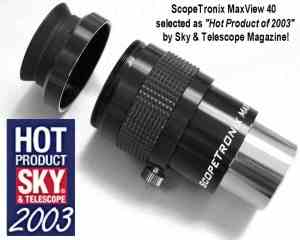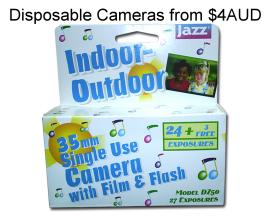DIGITAL CAMERA ADAPTERS
TELESCOPES AND ASTRONOMY
Whether its a Camera, Digital Camera or CamCorder, ScopeTronix has the Adapter to fit all. Your camera can be attached easily to a Telescope, Spotting Scope or Microscope. A special product, invented by ScopeTronix, is the MaxView 40 which gives a brilliant wide field of view when used with an adapter. Telescopes and Astronomy specialise in camera imaging through optics. Call or email us for all the ScopeTronix range and many other accessories for imaging.Which adapter you need depends mainly on the camera you have and the telescope or eyepiece you wish to attach it to...
Our best recommendations to quickly select what you need are to follow these guidelines...
TELESCOPES
If you want to use your current telescope eyepieces look at our Digi-T Systems. Make sure you have a Digi-T compatible eyepiece as outlined here before ordering. So long as you have a suitable eyepiece the kit will have everything you need (including any necessary lens tubes or custom attachments) to get connected.
BUT there may be a better solution...
If you own:
Nikon: 800/950/990/995/4500 (or any other Nikon with a 28mm threaded lens) and a telescope that accepts 1.25" eyepieces look at our 14mm and 18mm Wide Angle Eyepiece/Adapters. These are by far the simplest, easiest, and best solution out there for these cameras. In addition they are one heck of a nice eyepiece for visual use too. Use the 18mm if you have a longer focal length SCT or Mak, use the 14mm for short focal length refractors.
If you own any of the following popular larger lensed cameras and a scope that accepts 1.25" eyepieces:
Canon: G1/G2/G3
Sony: DSCS70/75/80/85, F505/707/717, (and others with 52mm Lens thread).
Minolta: Dimage 5/7/7i/7hi
Nikon: 5700
Olympus: 2000/2020/2040/2100/3000/3020/3030/3040/4000Z/4040/5050
We highly recommend our MaxView 40 product. The MaxView 40 is a 1.25" eyepiece and camera adapter all in one. It is specifically designed to reduce vignetting on cameras with larger lenses. In addition to the MaxView 40 you will need the appropriate Attachment Kit for your particular camera.
If your telescope does not accept astronomical standard slip fit 1.25" eyepieces (such as with some spotting scopes) you will need to attach to whatever eyepiece your scope has. In this case look at our UniAdapt or Uni-T adapters. If none of these looks suitable take a look at our other adapters. All of our Adapters are "T" threaded so you will need the appropriate Attachment Kit to connect them to your camera.
SPOTTING SCOPES
If you have a spotting scope by Swarovski, Pentax, Leica, Bushnell, or Zeiss see our Digiscoping Adapters. You will also need an Attachment Kit for your particular camera.
MICROSCOPES
If you are trying to connect to a Microscope see our MaxView Plus kit. In addition to the MaxView Plus you will need the appropriate Attachment Kit for your particular camera.
Please call for further information.

DIGI-T CAMCORDER ATTACHMENT SYSTEM
How Does the Digi-T system work?The Digi-T system is quick, secure, and easy to use. The rubber eyeguard is removed from the eyepiece, The Digi-T threaded ring is slipped over the top of the eyepiece and the 3 set screws are tightened, with the included wrench, into the groove left vacant by the rubber eyeguard, the proper step ring then couples the Digi-T ring to the camera. In some cases a lens extension tube or intermediate ring may be required, these are included with the Digi-T system kits as needed.
Why is"Digi-T" better than a conventional eyepiece projection adapter?
Digi-T offers a number of significant advantages over conventional eyepiece projection adapters....
Less Vignetting - When coupling a camcorder to a telescope it is imperative that the eyepiece lens and the camcorder lens are as close together as possible, a separation of even 1/2" will result in an image like looking through a soda straw. When installed onto the eyepiece Digi-T is flush with the top. Thanks to Digi-T's exclusive "thread-through-thread" design the step ring then threads completely over it, adding zero length. No other adapter gets as close!
Fits More Eyepieces - There are 2 types of conventional eyepiece projection adapters, fixed length and variable. The fixed length adapters are too short to hold the most popular eyepieces (such as the 26mm Super Plossl) and too narrow to hold many others. The variable length adapters are designed for film cameras and are simply too long to allow the close coupling necessary for camcorders, in addition they are still too narrow to hold any of the wider field eyepieces. Digi-T fits a 4mm Plossl or a 40mm Plossl!
No Back Focus Problems - All conventional eyepiece projection adapters have one thing in common, they lift the eyepiece up in the holder by about 1". For many refractors and reflectors this is a serious problem as they can no longer reach focus! This is especially true with the popular ETX60/70 telescopes. Since Digi-T attaches to the top of the eyepiece it doesn't change the eyepiece position at all and focus remains the same.
Convenient - No need to search the world over for a bunch of oddball hard to find rings to attach your camera and then hoping they will all work together. In most cases you can have everything you need with a single click!
Which Camcorders will the Digi-T System fit?
The Digi-T system is available to fit most popular camcorders. Most are specific to a camcorder model and many more will fit the most common lens thread sizes. The only requirement is that the camcorder have a live LCD viewfinder screen (or through the lens view) so you can see to focus the image. Some of the camcorders currently supported are Canon, JVC, Panasonic, Sony, and more.
Which Eyepieces will the Digi-T System fit?
Digi-T fits most popular 1.25" eyepieces with removable rubber eyeguards... Specifically the Meade 4000 Series Plossls, Most 1.25" Meade SWA's and UWA's, Meade ETX 60/70 eyepieces, Celestron NexStar Plossls (newer type with rubber eyeguards only), ScopeTronix ST Series Plossls, Orion Sirius Plossls, Generic Series 300/400 Plossls, and many more imported eyepieces with removable rubber eyeguards. Digi-T will not fit TeleVue eyepieces. Our Adaptaview or Digadapt adapters will cover most other eyepieces. To see if your eyepiece will work if it is not listed above check it as follows. It must have a removable rubber eyeguard, once the eyeguard is removed the diameter of the TOP of the eyepiece (the portion above the groove that holds the eyeguard) must be between 1.22" and 1.26" for the best fit. If you don't have a compatible eyepiece we recommend either the ScopeTronix 25mm or 30mm Plossls. They have all the attributes necessary for good optical coupling to a digital camera (large lens, good eye relief, Digi-T compatibility, and a non-recessed lens design). You will find that it is more important to have a single eyepiece that couples well rather than a range of eyepieces in different focal lengths that don't couple well. The reason being that you can adjust the magnification by simply zooming the camera or adding a barlow before the lens.
A word on vignetting...?
Vignetting is a term photographers use to describe images which have the outer edges cut off. A vignetted image will look as if it were taken through a pipe...black edges surrounding a circle of an image. Vignetting is caused by several factors. The size of the eyepiece lens, the distance from the camcorder lens to the eyepiece lens, and probably most importantly the physical size of the camcorder lens. If you have a camcorder with a large lens such as many of the Panasonic models and you are shooting through a much smaller eyepiece you will experience some vignetting. This is the nature of the beast. The Digi-T will reduce vignetting to a minimum by getting the camcorder and eyepiece lenses as close as possible but on some camcorders there will be unavoidable vignetting. For planetary use this really isn't a problem as you can crop out the planet from the center of the image with image processing software. But for terrestrial use it can be a problem in some cases. If you haven't yet purchased a camcorder we highly recommend you buy one with a physically small lens to eliminate this problem. There are some ways to help reduce vignetting and here are some tips:
1. Use an eyepiece with a large lens such as a 25mm plossl. Check out our MaxView 40 below, a product specially designed to help with this problem. Remember due to the magnification provided by the camcorder you will already be at a higher power than you would be visually, you can always add a barlow before the eyepiece to increase magnification further.
2. Try the available modes on your camcorder. Generally, maximum zoom works best on most camcorders.
3. Keep lens distances to a minimum. On some eyepieces the lenses can be recessed quite a bit from the end of the eyepiece. For example the newer 26mm Super Plossl has the lens recessed about 1/2" into the body. While this won't affect camcorders with small lenses it will affect camcorders with large lenses. Our ScopeTronix 25mm and 30mm Plossls do not have recessed lenses and work very well with the Digi-T™ system.
To use your larger specialty eyepiece inquire about our ADAPTA VIEWS
Please call for further information
MAXVIEW 40
Many digital cameras vignette the least when everything is coupled as closely as possible. The MavView 40 is "T" threaded so you will need the proper step ring to mate it to your camera. We carry a large selection of step rings to fit most film and digital cameras. The MaxView 40 is a 1.25" eyepiece and offers the largest possible diameter lens that can fit through a "T" thread.
Vignetting may not be eliminated on all cameras but the difference will always be substantial. Remember that while this is a low power eyepiece you will typically be operating your camera at or near its maximum zoom which greatly increases the magnification. You can also use a Barlow lens before the eyepiece to further increase power. Generally reaching high power with a digital camera is easy, getting a wide field is the hard part!

Contact Us - telescopes@adam.com.au
Australian Callers: (08) 8381 3188 or 0416 123 096





